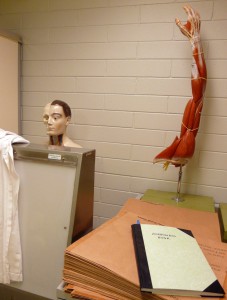Anatomy and Histology
Laboratory and Museum
School of Medicine
Flinders University
Adelaide
May 23rd 2011
Some Background…
I’ve been the Artist-in-Residence at the Autonomic Neurotransmission Laboratory, Anatomy and Histology, Flinders University working in collaboration with Anatomist/Neuroscientist, Professor Ian Gibbins since 2009
Ian and I met in 2007 during our involvement with a project called With the Body in Mind- a multidisciplinary art/sciences public forum presented through Flinders Arts in Health and the South Australian Neuroscience Institute at Flinders University. Our initial explorations looked at diverse representations of the normal and abnormal body in images, text and sound.
Since then we’ve cultivated a rich working relationship and have worked together on several significant art/science projects, most notably Not Absolute, a collaborative art/science development project and exhibition held at Flinders University Art Museum in 2009. It was during this project I became artist in residence in Anatomy and Histology, at Flinders.
Last year Ian and I were jointly awarded a Flinders University Teaching and Learning Innovation Grant to undertake our research project entitled Translating the Body: the choreography of representation in anatomy teaching, a project that explored the role of two and three-dimensional forms of representation in the communication of functional human anatomy to medical students. Some of the themes and questions that fed our collaborative process during the Teaching and learning Innovation project included:
What is the student’s point of reference when learning anatomy?
Whose body are they learning?
Direct, primary multi-sensory experience is crucial to the understanding of this infinitely complex subject. Each student must absorb and retain vast amounts of information and construct his or her own idealised model of the body, derived from their interaction with multiple specific examples: the anatomical specimens, the models, radiographic images, the textbook diagrams, the living body of the instructor and those of the students themselves.
The data we collected during the project- film, interviews, images, and questionnaires will form part of a rich resource for the current Synapse 6 Residency 2011. We keen to review the data to guide new research that will focus specifically upon an exploration and creative interpretation of the ambiguities and uncertainties inherent in the embodiment process and the filtered learning experience.
The Filtered Body: the uncertainties of embodiment
Our Synapse 6 is project entitled The Filtered Body: the uncertainties of embodiment. During this creative research project we plan to explore and create new forms of representational objects and digital media which encourage interaction through touch, gesture and language that facilitate more nuanced experiences of human anatomy.
This research will be based in the anatomy laborartory and museum here at Flinders and so I am firmly ensconced here once again!
The Anatomy Teaching Laboratory & Museum in the School of Medicine at Flinders University is a unique environment- featuring the latest live transmission video and audio technology that allows the instructor to demonstrate detailed anatomical specimens on large high definition screens and by video-conferencing to remote sites. This multi-dimensional learning environment is highly valued by the students however, learning detailed human anatomy is highly complex and at times reductive. Each student must absorb and retain vast amounts of information and construct his or her own idealised model of the body, derived from their interaction with multiple specific examples: the anatomical specimens, the models, radiographic images, the textbook diagrams, the living body of the instructor and those of the students themselves.
The problem of understanding the body and its representation is a problem of diverse domains including cognitive science, philosophy, social sciences and the creative arts. Ian and I have been dogged in our determination to create opportunities that have enabled us both to explore and identify some of the critical intersections of our practises pertinent to both art and science communities.
Ian has commented: Catherine’s unique insights into the students’ interaction with the learning environment of the Anatomy Teaching Laboratory already have influenced the development of new approaches to teaching, and the proposed residency will accelerate this development. The production of collaborative creative works from the residency will provide an avenue for widely disseminating our ideas of what happens during learning about the body in ways the extend far beyond usual academic discourse and formal reporting.
As and artist, I feel I am benefiting in many ways from the opportunity to directly interact in the teaching and the learning and research environments and gaining insight into the current practices of the ways in which the human body is communicated .
Yesterday was our first day of the Synapse project and even though we have a history of working together I feel we have only just scratched the surface in terms of the potential of this collaboration.

